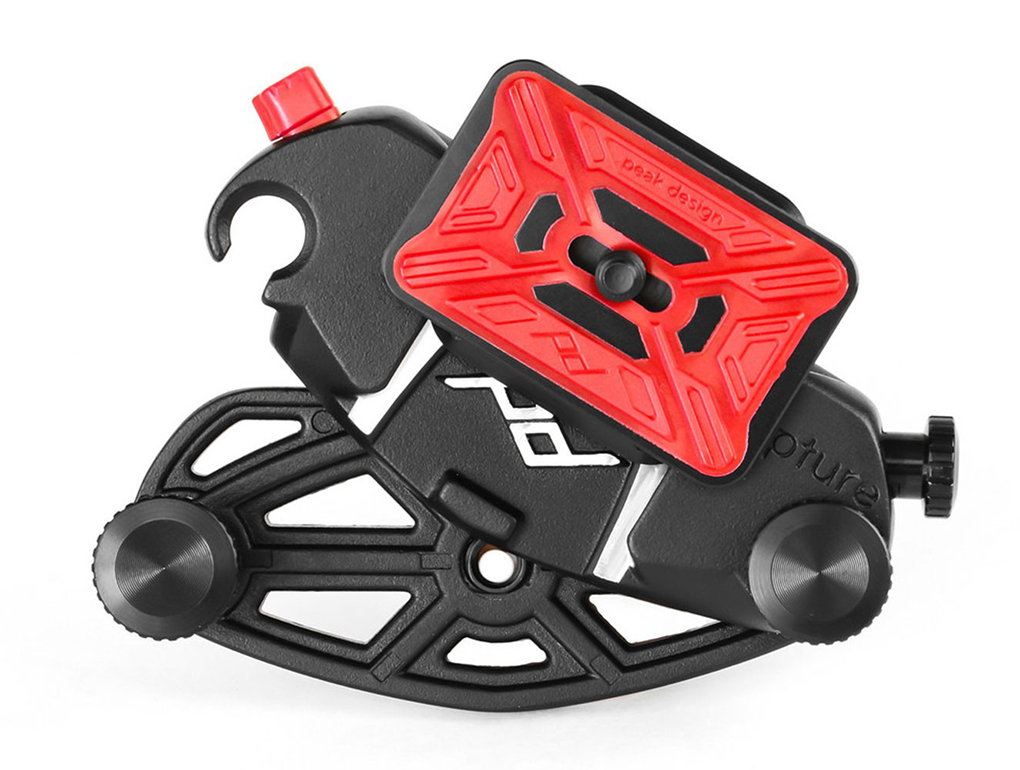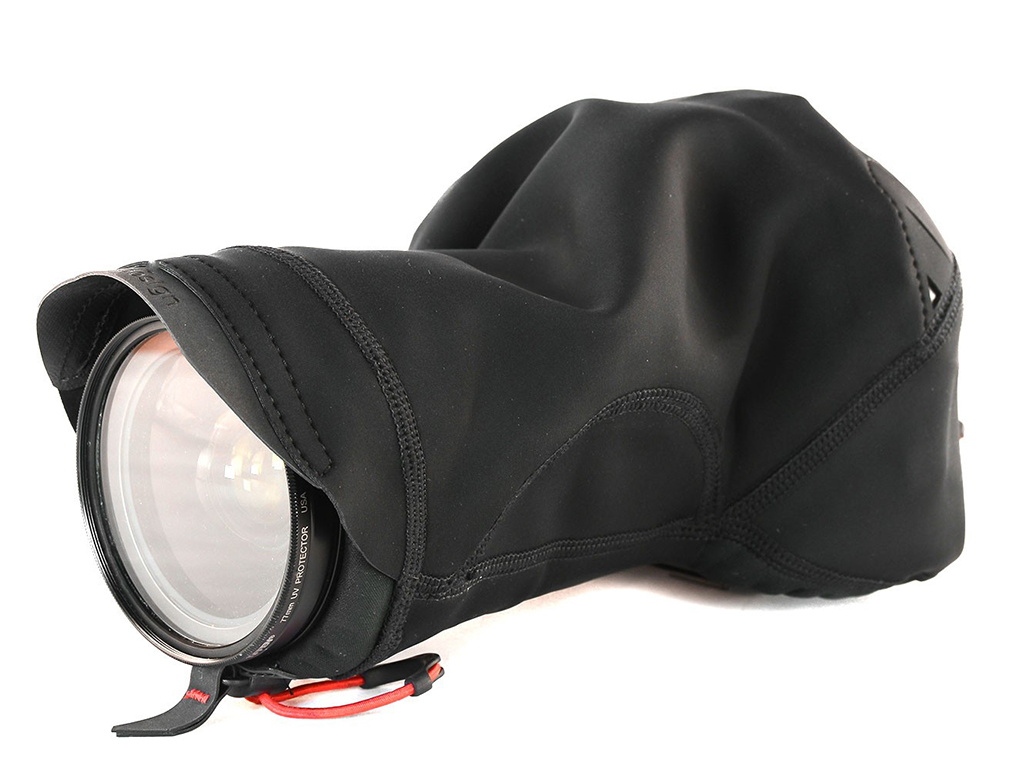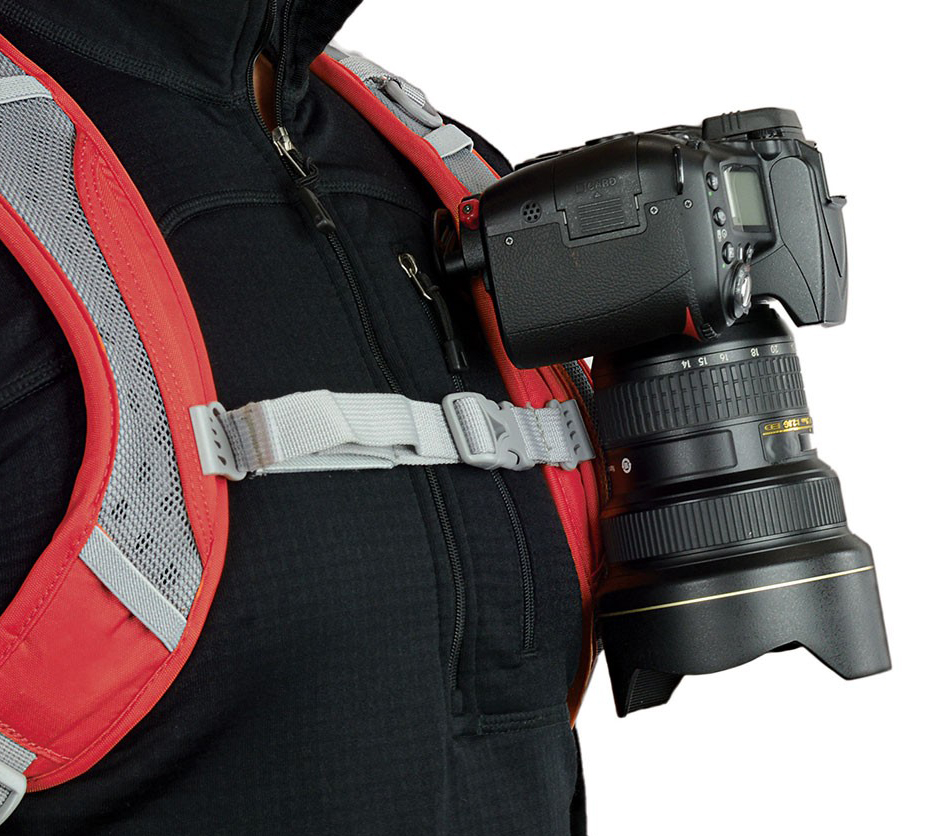
Peak Design Capture Pro & Shell
Capture Pro
Features:
- Works with straps up to 3 inches (7.6 cm) wide and 0.5 inches (1.3 cm) thick.
- All aluminum construction
- Button Safety Lock
- Quick-release lock withstands over 200 lbs. of force
MSRP: $79.95

Shell
Features:
- 4-way stretch fabric is seam-taped to resist rain, snow, dust and abrasion
- Access viewfinder and controls without removing
- Completely cinches closed for safe camera stowage
MSRP: $39.95 – $49.95
Intro
As an outdoors photographer, I’m constantly struggling with a conundrum: how to keep my expensive camera gear protected so that my investment doesn’t turn into a few mangled pieces of metal and plastic, while also keeping it accessible enough that I can shoot at opportune moments, which often come at unexpected and inconvenient times.
In the past, I’ve used a repurposed camo hunting fanny pack worn on my belly and loaded down with my camera body and extra lenses. With this setup, the camera was just a little protected, but very easily accessible. I then moved on to the Evoc CP 26l, which does a very good job of protecting my camera, but makes it a bit of a pain to access.
The Thule Upslope 35 has since become my default camera bag, since the huge hip pockets make it almost as convenient as the fanny pack without any of the negative connotations that surround one.
However, while the Upslope is more than adequate for most inbounds shooting, I still found myself wishing that my camera was a little more accessible when climbing and skiing in the backcountry. That’s where the Peak Design Capture Pro and Shell comes in.
Capture Pro
The Capture Pro is basically a quick release system that allows your camera to clip to any strap. I place mine on my backpack’s shoulder strap, but it can work on any other strap on your gear, or your belt. A plate screws into your camera’s tripod threads, which then allows it to lock to the strap.

The Capture Pro is Peak’s high-end, all-metal version. Also available is the $59.95 Capture, which uses a mixture of plastic and metal in its construction, but functions identically.
It’s very easy to set up; the quick release system clips onto the pack with two easy-to-tighten screws; and the kit comes with an allen wrench to bolt the plate onto your camera. While I do like quick release plates with a small folding wire handle that allows for tool-less swaps, the allen bolt makes for a more secure connection, and Peak Designs does sell extra quick release plates if you have multiple cameras you want to use with the system.
In the field, I’ve found the Capture Pro to be very confidence inspiring. There is an audible click when the camera is locked in, and you can twist the release button to fully lock it out for some extra peace of mind. Before I headed into the mountains, I yanked on the camera pretty hard to see if I could get it to pop out. I found that it stayed completely solid, which I greatly appreciated when climbing in steeper, no-fall zones.
In the weeks I’ve had the Capture Pro, it’s migrated from pack to pack depending on what sort of mission I’m on. The transfer takes about two minutes, with no tools required.
“Revolutionary” is a word that gets thrown around too much, but the Capture Pro has definitely changed the way I shoot in the mountains. My camera is always right there, in front of my chest, just a button push away. Having the camera this accessible means that I’m much more likely to pull it out and capture moments that would otherwise go unrecorded. Wayne Gretzky said that you miss 100% of the shots you don’t take, and the Capture Pro has caused me take more shots.

When climbing steep couloirs, the Capture Pro keeps the camera angled down, parallel with my torso. This means that snow is unlikely to get on the lens, unless I take a tumble or posthole down to my chest.
I can go from climbing to shooting with only one hand, without having to fiddle with any straps, buckles or zippers. That’s huge when I’m hanging off an ice axe and crampons on a steep slope with variable snow—nobody wants to wait for the photographer, especially when things get spicy.
So far, I haven’t had any trouble with the Capture Pro affecting the comfort of my pack. I expected it to create a pressure point under the strap and rub my chest, but I haven’t experienced that, and that’s after wearing it for the entirety of our Mt. Olympus trip. Some of this may be related to my sunk-chested build, but if you situate the Capture Pro on a part of the strap that isn’t being pulled directly into your body by the pack, I don’t think you’ll have any issues.
Of course, carrying the camera on the Capture Pro isn’t convenient all the time; it’s not really practical for me when skiing down—the camera has a tendency to bounce on the strap, and the faster I’m moving, the more I notice it there. However, in those quicker moving situations, I’ve found that it’s more convenient to have the athlete stop and set up the shot anyway, so I keep it in my bag.
I am excited to use the Capture Pro for hiking and backpacking this summer. It should be perfect for shooting on the go in these slower paced situations without having to take off my pack.
Peak Designs Shell
Of course, while having the camera out on the front of your pack is convenient, it also means that it’s exposed to the elements. The Peak Designs Shell is basically a waterproof sock for your camera. (Before anyone gets the wrong idea, the material of the shell is waterproof, but it’s not intended to make your camera waterproof in any way.)
In the past I’ve wrapped my camera in a buff or a plastic bag in an attempt to keep it dry; the Peak Designs Shell takes all of the inconvenience out of that situation. It fits over the camera with a drawstring around the lens, and another around the back screen and control area. There is a little brim over the lens, and both ends can be pulled over the camera and cinched down if the weather really deteriorates.
So far, I’ve found the Shell to be not quite as convenient and game changing as the Capture Pro, but that’s primarily because I’ve been blessed with good weather recently. But when things do get moist, the Shell is the most convenient solution I’ve found—the lens stays clear, and the brim helps keep water droplets off of it, while the back opens wide enough that all the controls are accessible.
It is initially hard to adjust focus and zoom through the Shell on the fly, but I quickly got accustomed to it. My only other gripe is that the holes for a strap are very small, I’m running a chunky, woven paracord wrist strap, and it was a chore to pull it through. If you’re running a regular strap, you will have to take at least one end off the camera and run it through the holes in the Shell to make it work. But that’s a minor inconvenience, especially given how hard it is to seal down most other forms of camera protection without limiting access to controls.
Sizing
I went with the Medium Shell since I’m shooting with a Canon 7d and Sony A7II. The Medium fits the 7d with a mid-sized lens perfectly, and works fine with a telephoto as well. Unfortunately, the A7II is a little small for the size Medium Shell (as Peak’s excellent sizing chart states). I can make it work, but the camera is definitely swimming in the shell, which makes it harder to keep the lens clear and access controls.
Price
$79.95 for the Capture Pro may seem steep. Manfrotto quick releases (generally considered to be the standard for quick release systems) typically cost about $40 for a set. That immediately led me to investigate adapting one of them (or one of the many cheap-but-solid Amazon knockoffs) to fill the same function as the Capture Pro. But to reproduce the Capture Pro’s ease of access and the ability to swap it between packs, it would take significantly more time and resources than it’s worth. If the price is really a deterrent, I’d suggest going with the less expensive Capture.
Bottom Line
Combined with the Shell, the Peak Design Capture Pro keeps my camera accessible and protected better than any other system I’ve used. As ski season winds down, I’m excited to swap it over to my backpacking and hiking packs.
They say that the best camera is the one you have with you, and the Capture Pro allows my camera to be with me and more accessible than ever before. It’s a rare piece of camera gear that accomplishes that, and Peak Designs has come up with a simple solution to one of my biggest dilemmas.

The Capture is probably the most underrated review on Blister. I can affirm all of Cy’s claims, it’s an absolute game changer for carrying an ILC in the outdoors. The vast majority of my use has been on hiking, backpacking, and cl. 2-3 peak bagging, with barely any times where I’ve wished the Capture worked better. So long as you backpack has a suitably padded and wide shoulder strap, my Fuji X-T2 with 18-135mm lens can just disappear on a 15 mile hike until I want to take a picture – in less than a second of transition time to boot. Reliably clipping the camera back on 1-handed is incredibly handy too. I honestly don’t know why more outdoor photographers aren’t using the Capture.
I love mine for skiing and moutnainbiking too.
If your shoulder strap isn’t to tight you can even fire off shots one handed while still leaving attached. I have even done this while riding on my bike, following my friends down a flow trail.
The one handed removal and re-insertion are truly key to outdoor use.
I set up my camera with a finger strap and mountain on the left shoulder.
To grab, I stick my index finger through the strap, and use my thumb to release it from the clip, in one motion the camera is in my hand, ready to shoot.